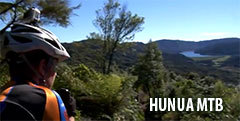Moumoukai Valley Willow Removal
 Click here for larger version, opening in new window.
Click here for larger version, opening in new window.
Update Winter 2015
Auckland Council have recently carried out willow control along the Mangatawhiri River. This is a continuation of the work started by Watercare last year, but has been carried out using a different methodology. The Watercare project removed the willows in their entirety to prevent them breaking down and clogging up the ford, Auckland Council has been working downstream of the ford where flooding is less of a risk so the trees have been killed standing. This means they will continue to provide shade to the river as the native vegetation regenerates.
Between the two projects willow has now been controlled all the way between the Mangatawhiri dam and the park boundary 9km down stream. Auckland Council will be continue to work on the willow control for the next few years, removing any surviving trees and carrying out riparian planting. This work should improve the health of the river and increase biodiversity.
Regular visitors to the lower Mangatawhiri area of Moumoukai Valley where most of Hunua's mountain bike tracks are situated will have noticed quite a change alongside the Mangatawhiri River.
During winter of 2014 Watercare arranged the removal of many mature willow trees that line the river banks (Crack and Grey Willows). These trees were planted decades ago just after construction of the Mangatawhiri Dam in 1965.
 However, it has been recognised in recent years that this was not really a good idea in hindsight: the willows were stunting the growth of many other species of wetland plants therefore creating a monoculture and hindering biodiversity.
However, it has been recognised in recent years that this was not really a good idea in hindsight: the willows were stunting the growth of many other species of wetland plants therefore creating a monoculture and hindering biodiversity.
Studies have been carried out that identify far less native insect life within willows than in native plant species canopy (another impact for biodiversity in that there is less food for insects and less food for native birds). Also their roots trap sediment and therefore raise the level of the stream bed in this case making the river flood down the road when in flood.
Contractors felled the large trees in late summer, stacking them into pils for winter burning. Timing is crucial, ensuring herbicides are applied when the trees have plenty of leaves circulating nutrients and water through their trunks.
Now the willows are gone hopefully the riverbed will scour out and deepen.
You can see by the picture below the contractors also helped things along by planting natives either side of the river bank. Regular MTB rider of the valley Elvis Zaskarelli likes what he sees: "We can now see the river flowing, we get more light along that stretch of the road into the trail network and it is going to be great to watch it develop. Before you know it, the seedlings will have matured and we will be enjoying nice views with the chirping symphony of native birdlife."
Well said Elvis!
Other links
Some pics of the work by A&S Clearing.

Some native seedlings have been planted along the river banks to speed up the restoration of the area and attract native fauna.





















